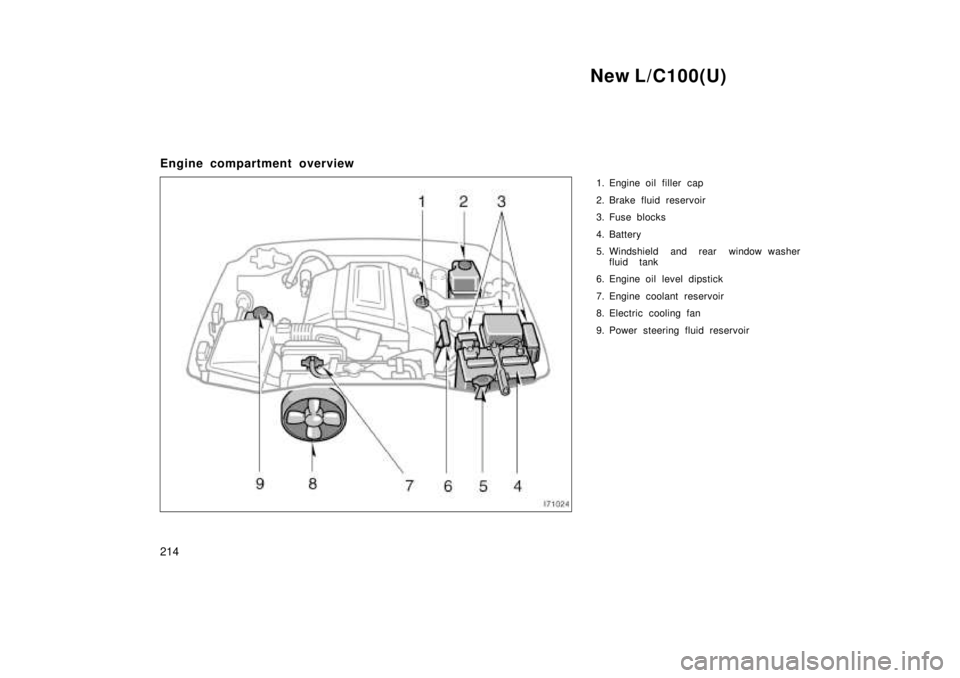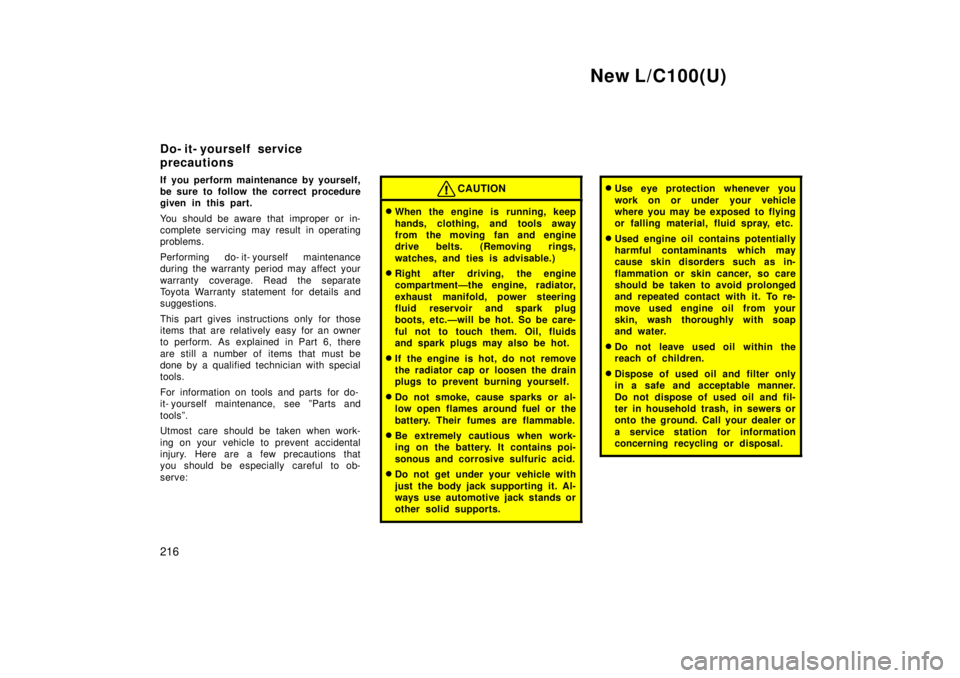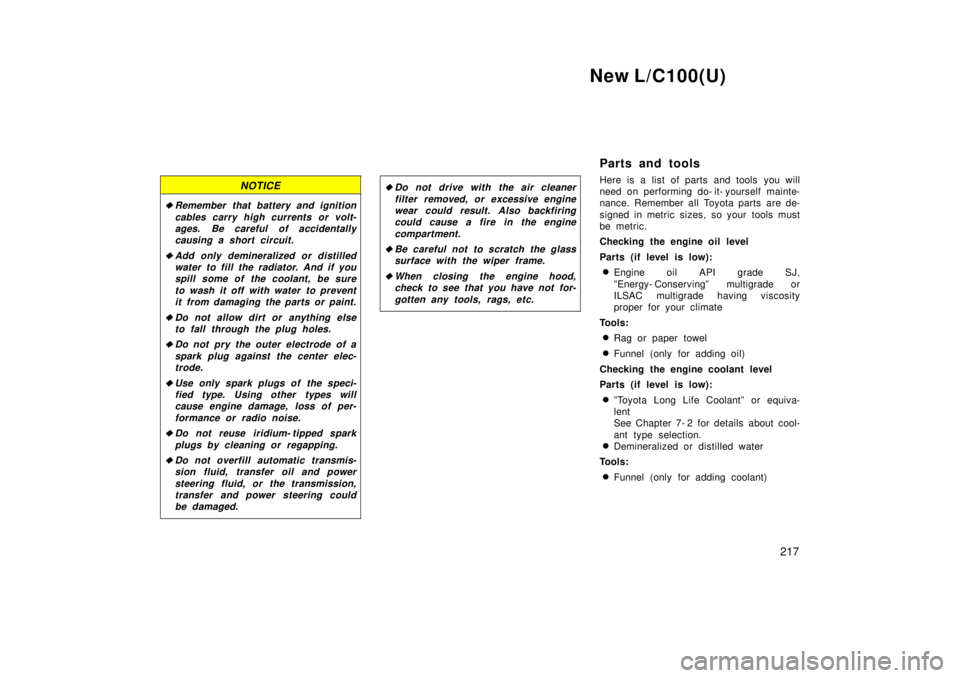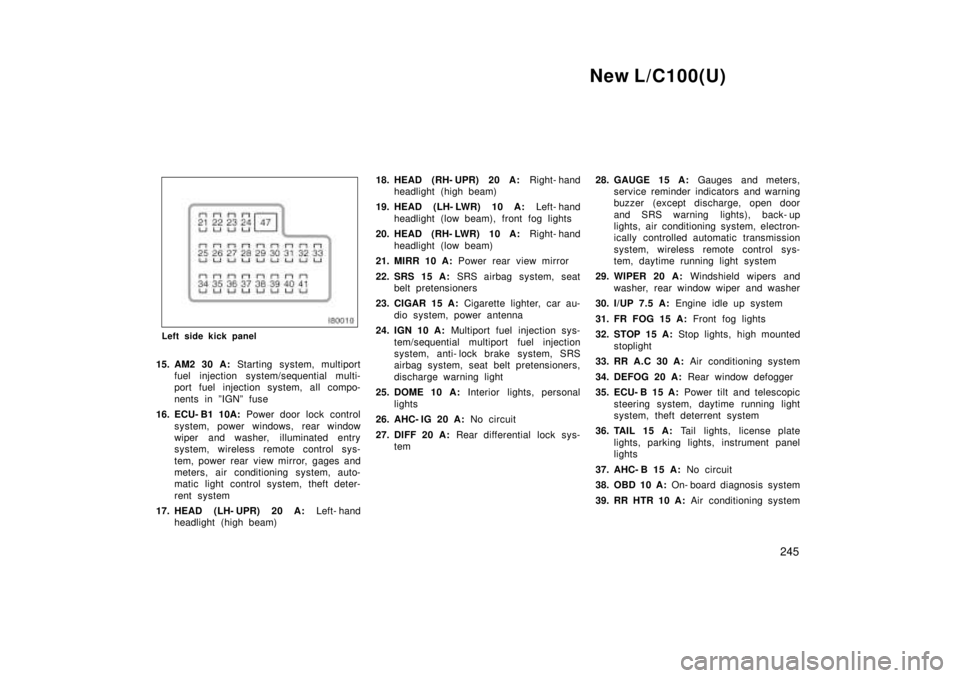1999 TOYOTA LAND CRUISER steering
[x] Cancel search: steeringPage 181 of 202

New L/C100(U)209
Tire surface and wheel nuts
Check the tires carefully for cuts, damage
or excessive wear. See Chapter 7- 2 for
additional information. When checking the
tires, make sure no nuts are missing, and
check the nuts for looseness. Tighten
them if necessary.
Tire rotation
Rotate the tires every 12000 km (7500
miles). See Chapter 7- 2 for additional in-
formation.
Fluid leaks
Check underneath for leaking fuel, oil, wa-
ter or other fluid after the vehicle has
been parked for a while. If you smell fuel
fumes or notice any leak, have the cause
found and corrected immediately.
Doors and engine hood
Check that all doors and back door oper-
ate smoothly and all latches lock securely.
Make sure the engine hood secondary
latch secures the hood from opening when
the primary latch is released.
INSIDE THE VEHICLE
Items listed below should be checked
regularly, e.g. while performing periodic
services, cleaning the vehicle, etc.
Lights
Make sure the headlights, stop lights, tail
lights, turn signal lights, and other lights
are all working. Check headlight aim.
Service reminder indicators and warning
buzzers
Check that all service reminder indicators
and warning buzzers function properly.
Steering wheel
Be alert for changes in steering condition,
such as hard steering or strange noise.
Seats
Check that all front seat controls such as
seat adjusters, seatback recliner, etc. op-
erate smoothly and that all latches lock
securely in any position. Check that the
head restraint move up and down smooth-
ly and that the locks hold securely in any
latched position. For folding- down rear
seatbacks, swing- up rear seat cushions
and detachable third seats, check that the
latches lock securely.Seat belts
Check that the seat belt system such as
buckles, retractors and anchors operate
properly and smoothly. Make sure that the
belt webbing is not cut, frayed, worn or
damaged.
Accelerator pedal
Check the pedal for smooth operation and
uneven pedal effort or catching.
Brake pedal
Check the pedal for smooth operation and
that the pedal has the proper clearance.
Check the brake booster function.
Brakes
At a safe place, check that the brakes do
not pull to one side when applied.
Parking brake
Check that the lever has the proper travel
and that, on a safe incline, your vehicle
is held securely with only the parking
brake applied.
Page 182 of 202

New L/C100(U)
210
Automatic transmission ºParkº mecha-
nism
Check the lock release button of the se-
lector lever for proper and smooth opera-
tion. On a safe incline, check that your
vehicle is held securely with the selector
lever in ºPº position and all brakes re-
leased.
IN THE ENGINE COMPARTMENT
Items listed below should be checked
from time to time, e.g. each time when
refueling.
Washer fluid
Make sure there is sufficient fluid in the
tank. See Chapter 7- 3 for additional in-
formation.
Engine coolant level
Make sure the coolant level is between
the ºFULLº and ºLOWº lines on the see-
through reservoir when the engine is cold.
See Chapter 7- 2 for additional information.
Battery electrolyte level
Make sure the electrolyte level of all bat-
tery cells is between upper and lower lev-
el lines on the case. Add only distilled
water when replenishing. See Chapter 7- 3
for additional information.
Brake fluid level
Make sure the brake fluid level is correct.
See Chapter 7- 2 for additional information.
Engine oil level
Check the level on the dipstick with the
engine turned off and the vehicle parked
on a level spot. See Chapter 7- 2 for addi-
tional information.
Power steering fluid level
Check the level through the reservoir. The
level should be in the ºHOTº or ºCOLDº
range depending on the fluid temperature.
See Chapter 7- 2 for additional information.
Exhaust system
If you notice any change in the sound of
the exhaust or smell exhaust fumes, have
the cause located and corrected immedi-
ately. (See engine exhaust cautions in
Part 2.)
Be on the alert for changes in perfor-
mance, sounds, and visual tip- offs that
indicate service is needed. Some impor-
tant clues are as follows:
� Engine missing, stumbling, or pinging
� Appreciable loss of power
� Strange engine noises
� A leak under the vehicle (however, wa-
ter dripping from the air conditioning
after use is normal.)
� Change in exhaust sound (This may
indicate a dangerous carbon monoxide
leak. Drive with the windows open and
have the exhaust system checked im-
mediately.)
� Flat- looking tire; excessive tire squeal
when cornering; uneven tire wear
� Vehicle pulls to one side when driving
straight on a level road
� Strange noises related to suspension
movement
� Loss of brake effectiveness; spongy
feeling brake pedal; pedal almost
touches floor; vehicle pulls to one side
when braking
� Engine coolant temperature continually
higher than normal
Does your vehicle need
repairing?
Page 186 of 202

New L/C100(U)
214
Engine compartment overview
1. Engine oil filler cap
2. Brake fluid reservoir
3. Fuse blocks
4. Battery
5. Windshield and rear window washerfluid tank
6. Engine oil level dipstick
7. Engine coolant reservoir
8. Electric cooling fan
9. Power steering fluid reservoir
Page 188 of 202

New L/C100(U)
216
If you perform maintenance by yourself,
be sure to follow the correct procedure
given in this part.
You should be aware that improper or in-
complete servicing may result in operating
problems.
Performing do- it- yourself maintenance
during the warranty period may affect your
warranty coverage. Read the separate
Toyota Warranty statement for details and
suggestions.
This part gives instructions only for those
items that are relatively easy for an owner
to perform. As explained in Part 6, there
are still a number of items that must be
done by a qualified technician with special
tools.
For information on tools and parts for do-
it- yourself maintenance, see ºParts and
toolsº.
Utmost care should be taken when work-
ing on your vehicle to prevent accidental
injury. Here are a few precautions that
you should be especially careful to ob-
serve:
CAUTION
�
When the engine is running, keep
hands, clothing, and tools away
from the moving fan and engine
drive belts. (Removing rings,
watches, and ties is advisable.)
� Right after driving, the engine
compartmentÐthe engine, radiator,
exhaust manifold, power steering
fluid reservoir and spark plug
boots, etc.Ðwill be hot. So be care-
ful not to touch them. Oil, fluids
and spark plugs may also be hot.
� If the engine is hot, do not remove
the radiator cap or loosen the drain
plugs to prevent burning yourself.
� Do not smoke, cause sparks or al-
low open flames around fuel or the
battery. Their fumes are flammable.
� Be extremely cautious when work-
ing on the battery. It contains poi-
sonous and corrosive sulfuric acid.
� Do not get under your vehicle with
just the body jack supporting it. Al-
ways use automotive jack stands or
other solid supports.
�Use eye protection whenever you
work on or under your vehicle
where you may be exposed to flying
or falling material, fluid spray, etc.
� Used engine oil contains potentially
harmful contaminants which may
cause skin disorders such as in-
flammation or skin cancer, so care
should be taken to avoid prolonged
and repeated contact with it. To re-
move used engine oil from your
skin, wash thoroughly with soap
and water.
� Do not leave used oil within the
reach of children.
� Dispose of used oil and filter only
in a safe and acceptable manner.
Do not dispose of used oil and fil-
ter in household trash, in sewers or
onto the ground. Call your dealer or
a service station for information
concerning recycling or disposal.
Do- it- yourself service
precautions
Page 189 of 202

New L/C100(U)217
NOTICE
�Remember that battery and ignitioncables carry high currents or volt-ages. Be careful of accidentally causing a short circuit.
�Add only demineralized or distilledwater to fill the radiator. And if you spill some of the coolant, be sure
to wash it off with water to preventit from damaging the parts or paint.
�Do not allow dirt or anything elseto fall through the plug holes.
�Do not pry the outer electrode of a
spark plug against the center elec-trode.
�Use only spark plugs of the speci-fied type. Using other types will cause engine damage, loss of per-
formance or radio noise.
�Do not reuse iridium- tipped sparkplugs by cleaning or regapping.
�Do not overfill automatic transmis-sion fluid, transfer oil and power
steering fluid, or the transmission,transfer and power steering couldbe damaged.
�Do not drive with the air cleaner
filter removed, or excessive enginewear could result. Also backfiringcould cause a fire in the engine
compartment.
�Be careful not to scratch the glasssurface with the wiper frame.
�When closing the engine hood,check to see that you have not for-
gotten any tools, rags, etc.
Parts and tools
Here is a list of parts and tools you will
need on performing do- it- yourself mainte-
nance. Remember all Toyota parts are de-
signed in metric sizes, so your tools must
be metric.
Checking the engine oil level
Parts (if level is low):
� Engine oil API grade SJ,
ºEnergy- Conservingº multigrade or
ILSAC multigrade having viscosity
proper for your climate
Tools: � Rag or paper towel
� Funnel (only for adding oil)
Checking the engine coolant level
Parts (if level is low): � ºToyota Long Life Coolantº or equiva-
lent
See Chapter 7- 2 for details about cool-
ant type selection.
� Demineralized or distilled water
Tools:
� Funnel (only for adding coolant)
Page 190 of 202

New L/C100(U)
218
Checking brake fluid
Parts (if level is low):
� SAE J1703 or FMVSS No.116 DOT 3
brake fluid
Tools:
� Rag or paper towel
� Funnel (only for adding fluid)
Checking power steering fluid
Parts (if level is low):
Automatic transmission fluid DEXRON �
II
or III
Tools:
� Rag or paper towel
� Funnel (only for adding fluid)
Checking battery condition
Tools: � Warm water
� Baking soda
� Grease
� Conventional wrench (for terminal
clamp bolts) Checking and replacing fuses
Parts (if replacement is necessary):
� Fuse with same amperage rating as
original
Adding washer fluid
Parts: � Water
� Washer fluid containing antifreeze (for
winter use)
Tools: � Funnel
Replacing light bulbs
Parts:
� Bulb with same number and wattage
rating as original (See charts in ºRe-
placing light bulbsº in Chapter 7- 3.)
Tools:
� Screwdriver
Page 193 of 202

New L/C100(U)243
AUTOMATIC TRANSMISSION
Fluid capacity (drain and ref
ill), L (qt.,
Imp. qt.)
Up to 3.5 (3.7, 3.1)
Fluid type: Automatic transmission fluid D±II or DEXRON �
III (DEXRON �
II)
TRANSFER
Oil capacity, L (qt., Imp. qt.) 1.3 (1.4, 1.1)
Oil type: Gear oil API GL- 4 or GL- 5
Recommended oil viscosity: SAE 75W- 90
DIFFERENTIAL
Oil capacity, L (qt., Imp. qt.): Front 1.7 (1.8, 1.5) Rear
With rear differential lock system
3.2 (3.4, 2.8)
Without rear differential lock system 3.3 (3.5, 2.9) Oil type:
Standard differential Hypoid gear oil API GL- 5
Limited slip differential Hypoid gear oil for limited slip differ-
ential API GL- 5
Recommended oil viscosity: Above -18 �C (0 �F)
SAE 90
Below -18 �C (0 �F)
SAE 80W or 80W- 90
CHASSIS LUBRICATION
Wheel bearings: Lithium base wheel bearing grease,
NLGI No.2
Front drive shaft thrust bushings: Synthetic oil and lithium soap base
chassis grease, NLGI No.1
Propeller shafts: Lithium base wheel bearing grease,
NLGI No.2 BRAKES
Minimum pedal clearance when depressed
with the pressure of 490 N (50 kgf, 110
lbf) with the engine running, mm (in.):
116 (4.6)
Pedal freeplay, mm (in.): 1Ð6 (0.04Ð0.24)
Pad wear limit, mm (in.):
1.0 (0.04)
Lining wear limit, mm (in.): 1.0 (0.04)
Parking brake adjustment when pulled with
the force of 196 N (20 kgf, 44 lbf): 4Ð6 clicks
Fluid type: SAE J1703 or FMVSS No.116 DOT 3
STEERING
Wheel freeplay: Less than 40 mm (1.6 in.)
Power steering fluid type: Automatic transmission fluid DEXRON �
II
or III
Page 195 of 202

New L/C100(U)245
Left side kick panel
15. AM2 30 A: Starting system, multiport
fuel injection system/sequential multi-
port fuel injection system, all compo-
nents in ºIGNº fuse
16. ECU- B1 10A: Power door lock control
system, power wi ndows, rear window
wiper and washer, illuminated entry
system, wireless remote control sys-
tem, power rear view mirror, gages and
meters, air conditioning system, auto-
matic light control system, theft deter-
rent system
17. HEAD (LH- UPR) 20 A: Left- hand
headlight (high beam) 18. HEAD (RH- UPR) 20 A:
Right- hand
headlight (high beam)
19. HEAD (LH- LWR) 10 A: Left- hand
headlight (low beam), front fog lights
20. HEAD (RH- LWR) 10 A: Right- hand
headlight (low beam)
21. MIRR 10 A: Power rear view mirror
22. SRS 15 A: SRS airbag system, seat
belt pretensioners
23. CIGAR 15 A: Cigarette lighter, car au-
dio system, power antenna
24. IGN 10 A: Multiport fuel injection sys-
tem/sequential multiport fuel injection
system, anti- lock brake system, SRS
airbag system, seat belt pretensioners,
discharge warning light
25. DOME 10 A: Interior lights, personal
lights
26. AHC- IG 20 A: No circuit
27. DIFF 20 A: Rear differential lock sys-
tem 28. GAUGE 15 A:
Gauges and meters,
service reminder indicators and warning
buzzer (except discharge, open door
and SRS warning lights), back- up
lights, air conditioning system, electron-
ically controlled automatic transmission
system, wireless remote control sys-
tem, daytime running light system
29. WIPER 20 A: Windshield wipers and
washer, rear window wiper and washer
30. I/UP 7.5 A: Engine idle up system
31. FR FOG 15 A: Front fog lights
32. STOP 15 A: Stop lights, high mounted
stoplight
33. RR A.C 30 A: Air conditioning system
34. DEFOG 20 A: Rear window defogger
35. ECU- B 15 A: Power tilt and telescopic
steering system, daytime running light
system, theft deterrent system
36. TAIL 15 A: Tail lights, license plate
lights, parking lights, instrument panel
lights
37. AHC- B 15 A: No circuit
38. OBD 10 A: On- board diagnosis system
39. RR HTR 10 A: Air conditioning system